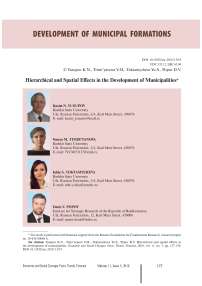Hierarchical and spatial effects in the development of municipalities
Автор: Yusupov Kasim N., Timiryanova Venera M., Toktamysheva Iuliia S., Popov Denis V.
Журнал: Economic and Social Changes: Facts, Trends, Forecast @volnc-esc-en
Рубрика: Development of municipal formations
Статья в выпуске: 5 (59) т.11, 2018 года.
Бесплатный доступ
. Thepaperpresentstheresultsofanalysisoftheinfluenceofseparatelevelsofpublicadministration hierarchy (regional, municipal) and neighboring territories on the indicators of socio-economic condition of municipal entities. The study was conducted in the context of 300 municipal entities of six subjects of the Russian Federation. The hierarchical and spatial effects were determined in several stages. The impact of separate administration levels on the results obtained by municipal entities was assessed with the use of hierarchical linear modeling (HLM), which is applied in other scientific fields to analyze group and inter-group relations. The connectedness of municipalities was evaluated with the use of spatial statistics methods (Moran Index). The analysis has shown that both vertical and horizontal connections of municipal entities are important. They determine spatial and hierarchical effects. Assessing the change in a given indicator, taking into account both the internal potential and the existing external horizontal and vertical links simultaneously is the most difficult but necessary step in the formation of management decisions regarding municipal entities...
Management hierarchy, multilevel analysis, spatial effect, regional administration
Короткий адрес: https://sciup.org/147224089
IDR: 147224089 | УДК: 332.12 | DOI: 10.15838/esc.2018.5.59.9
Список литературы Hierarchical and spatial effects in the development of municipalities
- Stein M., Turkewitsch L. The Concept of Multi-level Governance in Studies of Federalism. 2008 International Political Science Association (IPSA) International Conference -International Political Science: New Theoretical and Regional Perspectives. Montréal, Québec, Canada: Concordia University, 2008. pp. 2-35.
- Hooghe L., Marks G. Types of multi-level governance. Les cahiers europeens de sciences po, 2002, no. 3, p. 7. Available at: https://www.sciencespo.fr/centre-etudes-europeennes/sites/sciencespo.fr.centre-etudes-europeennes/files/n3_2002_final.pdf
- Andrichenko L.V. Division of powers between the authorities of different territorial levels: the problem of centralization and decentralization. Voprosy gosudarstvennogo i munitsipal’nogo upravleniya=Pubic Administration Issues, 2013, no. 4, pp. 37-58..
- Bulatova O.V. The structure-level organization of the system of economic management in sub-regional structures. Biznes v zakone=Business in Law, 2010, no. 1, pp. 258-260..
- Gibson C.C., Williams J.T., Ostrom E. Local Enforcement and Better Forests. World Development, 2005, vol. 33, no. 2, pp. 273-284 DOI: 10.1016/j.worlddev.2004.07.013
- Smith A. Emerging in between: The multi-level governance of renewable energy in the English regions. Energy Policy, 2007, vol. 35, pp. 6266-6280 DOI: 10.1016/j.enpol.2007.07.023
- Moellering H., Tobler W. Geographical Variances. Geographical Analysis, 1972, no. 4, pp. 35-50.
- Kaspshitskaya T.V. Regional’nyi mekhanizm sokrashcheniya razlichii v urovnyakh sotsial’no-ekonomicheskogo razvitiya gorodskikh okrugov i munitsipal’nykh raionov: dis. … kand. ekon. nauk: 08.00.05 . Moscow, 2015. 180 p.
- Antikainen J., Perttu V. Finnish districts and regional differentiation. Fennia, 2002, no. 180(1-2), pp. 183-190.
- Murgaš F., Klobučník M. Municipalities and Regions as Good Places to Live: Index of Quality of Life in the Czech Republic. Applied Research in Quality of Life, 2016, vol. 11, no. 2, pp. 553-570. DOI 10.1007/s11482-014-9381-8
- Haddad M.A., Nedović-Budić Z. Using Spatial Statistics to Analyze Intra-urban Inequalities and Public Intervention in São Paulo, Brazil. Journal of Human Development, 2006, vol. 7(1), pp. 85-109 DOI: 10.1080/14649880500502102
- Ye X., Wei Y.D. Geospatial Analysis of Regional Development in China: The Case of Zhejiang Province and the Wenzhou Model. Eurasian Geography and Economics, 2005, vol. 46(6), pp. 445-464 DOI: 10.2747/1538-7216.46.6.445
- Faizliev A.R. Matematicheskie metody i modeli analiza prostranstvennoi struktury sistemy gorodskoi torgovli: dis. … kand. ekon. nauk: 08.00.13 . Volgograd, 2014. 178 p.
- Gafarova E.A. Empirical models of regional economic growth with spatial effects: comparative analysis results. Vestnik Permskogo universiteta. Seriya: Ekonomika= Perm University Herald. Economy, 2017, vol. 12, no. 4, pp. 561-574..
- Zhao X.B., Tong S.P. Unequal Economic Development in China: Spatial Disparities and Regional Policy Reconsideration 1985-1995. Regional Studies, 2000, vol. 34 (6), pp. 549-561 DOI: 10.1080/00343400050085666
- Laan L. Changing Urban Systems: An Empirical Analysis at Two Spatial Levels. Regional Studies, 1998, vol. 32(3), pp. 235-247 DOI: 10.1080/00343409850119733
- Sinel’nikova-Muryleva S.G., Radygina A.D. (Eds.). Mau V. et al. Rossiiskaya ekonomika v 2016 godu. Tendentsii i perspektivy=Russian Economy in 2016. Trends and prospects. Issue 38. Moscow: Izd-vo In-ta Gaidara, 2017. 520 p.
- Garson D. Hierarchical linear modeling: guide and applications. USA: SAGE Publications Inc., 2013. 371 p DOI: 10.4135/9781483384450
- Goldstein H. Multilevel Statistical Models: 4th Edition. Wiley, 2010. 384 p.
- Khalikova A.A., Lakman I.A. Multi-level regression modeling of demand on the labor market in the city of Ufa. Matematicheskoe modelirovanie v ekonomike, strakhovanii i upravlenii riskami: sbornik materialov IV Mezhdunarodnoi molodezhnoi nauchno-prakticheskoi konferentsii: v 2-kh tomakh , 2015. Pp. 267-272..
- Huta V. When to Use Hierarchical Linear Modelling. The Quantitative Methods for Psychology, 2014, vol. 10 (1), pp. 13-28 DOI: 10.20982/tqmp.10.1.p013
- Edwards L.K. (Ed.). Raudenbush S.W. Hierarchical linear models and experimental design. Applied analysis of variance in behavioral science. New York: Marcel Dekker, 1993. pp. 459-496.
- Anselin L. Spatial Dependence and Spatial Structural Instability in Applied Regression Analysis. Journal of Regional Science, 1990, no. 30, pp. 185-207.
- Moran P. The interpretation of statistical maps. Journal of the Royal Statistical Society, 1948, series B, vol.10, pp. 243-251.
- Geary R. The contiguity ratio and statistical mapping. The Incorporated Statistician, 1954, vol.5, pp. 115-145.
- Imamova E.V, Tikhomirova T.P. Mekhanizm formirovaniya dokhodov naseleniya Rossii . Ekaterinburg: Izd-vo GOU VPO "Ros. gos. prof.-ped. un-t", 2007. 126 p.
- Surinov A.E. Dokhody naseleniya: Opyt kolichestvennykh izmerenii . Moscow: Finansy i statistika, 2000. 432 p.
- Kostyleva L.V. Neravenstvo naseleniya Rossii: tendentsii, faktory, regulirovanie: monografiya . Vologda: Institut sotsial’no-ekonomicheskogo razvitiya territorii RAN, 2011. Pp. 90-91.
- Woltman H., Feldstain A., MacKay J. Ch., Rocchi M. An introduction to hierarchical linear modeling. Tutorials in Quantitative Methods for Psychology, 2012, vol. 8(1), pp. 52-69 DOI: 10.20982/tqmp.08.1.p052


